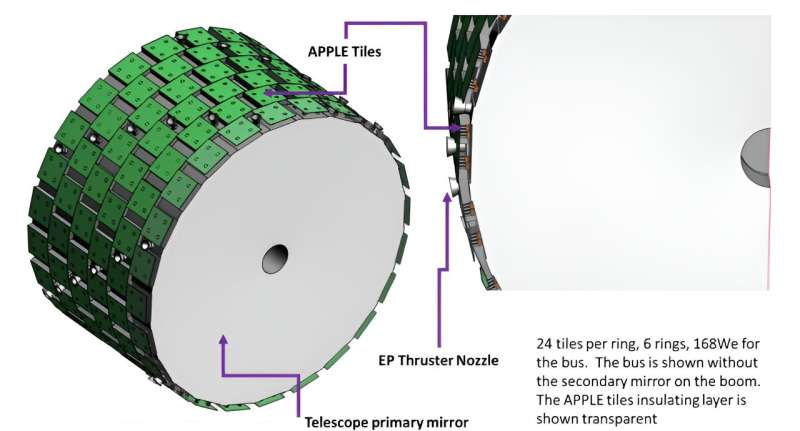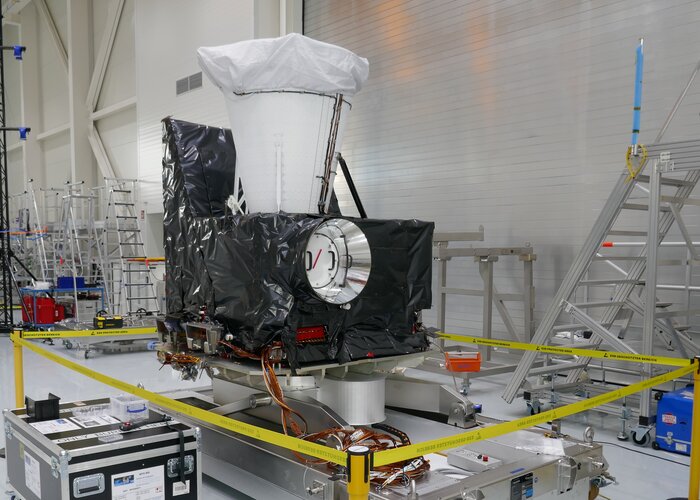
Copernical Team
An improved radioisotope thermoelectric generator could dramatically reduce the weight of interplanetary missions

Radioisotope thermoelectric generators (RTGs) are the power plants of the interplanetary spacecraft. Or at least they have been for going on 50 years now. But they have significant drawbacks, the primary one being that they're heavy. Even modern-day RTG designs run into the hundreds of kilograms, making them useful for large-scale missions like Perseverance but prohibitively large for any small-scale mission that wants to get to the outer planets. Solar sails aren't much better, with a combined solar sail and battery system, like the one on Juno, coming in at more than twice the weight of a similarly powered RTG.
To solve this problem, a group of engineers from the Aerospace Corporation and the US Department of Energy's Oak Ridge National Lab came up with a way to take the underlying idea of an RTG and shrink it dramatically to the point where it could not potentially be used for much smaller missions.
Putting the S in the first Meteosat Third Generation Sounder

Following on from the launch of the first Meteosat Third Generation weather satellite, MTG-I1, last December, the focus is now on getting its partner satellite, MTG-S1, ready for liftoff next year – and a significant milestone has been reached. The satellite has been equipped with its main instrument, the Infrared Sounder, hence the satellite’s name, and also the Copernicus Sentinel-4 instrument, an ultraviolet, visible, near-infrared light spectrometer, or UVN for short.
Illuminating Earth’s shine

A climate experiment called Earthshine is part of ESA astronaut Andreas Mogensen’s Huginn mission. The experiment aims to understand how Earth reflects sunlight to improve climate models. And you can help Andreas and the scientists!
Gaia telescope data challenges long-held gravity theories
 A groundbreaking study, harnessing observations from the European Space Agency's Gaia space telescope, has revealed evidence of discrepancies between observed stellar motions and predictions from Newton's universal law of gravitation and Einstein's general relativity.
The research, spearheaded by Professor Kyu-Hyun Chae of Sejong University, Seoul, scrutinized the orbital dynamics of appro
A groundbreaking study, harnessing observations from the European Space Agency's Gaia space telescope, has revealed evidence of discrepancies between observed stellar motions and predictions from Newton's universal law of gravitation and Einstein's general relativity.
The research, spearheaded by Professor Kyu-Hyun Chae of Sejong University, Seoul, scrutinized the orbital dynamics of appro New technique measures structured light in a single shot
 Structured light waves with spiral phase fronts carry orbital angular momentum (OAM), attributed to the rotational motion of photons. Recently, scientists have been using light waves with OAM, and these special "helical" light beams have become very important in various advanced technologies like communication, imaging, and quantum information processing. In these technologies, it's crucial to k
Structured light waves with spiral phase fronts carry orbital angular momentum (OAM), attributed to the rotational motion of photons. Recently, scientists have been using light waves with OAM, and these special "helical" light beams have become very important in various advanced technologies like communication, imaging, and quantum information processing. In these technologies, it's crucial to k New insights into the potential for early steps of biological evolution on Mars
 That the planet Mars had habitable surface environments early in its existence has been firmly established by the scientific community. These environments provided water, energy sources, elements like carbon, hydrogen, nitrogen, oxygen, phosphorus, and sulfur, as well as critical catalytic transition metals associated with life as we know it. However, whether that potential stimulated further pr
That the planet Mars had habitable surface environments early in its existence has been firmly established by the scientific community. These environments provided water, energy sources, elements like carbon, hydrogen, nitrogen, oxygen, phosphorus, and sulfur, as well as critical catalytic transition metals associated with life as we know it. However, whether that potential stimulated further pr Blazing a path to the Gediz Vallis Ridge: Sols 3914-3915
 Earth planning date: Wednesday August 8, 2023: Curiosity continues her steady winter drive through the Kalavryta quadrangle with her sights set on the Gediz Vallis ridge ahead! Behind her, Curiosity leaves evidence of her route as wheel tracks in the sand and dust - a robotic version of footprints on the Martian surface. Interestingly, the gaps in the rover wheels were designed with a pattern th
Earth planning date: Wednesday August 8, 2023: Curiosity continues her steady winter drive through the Kalavryta quadrangle with her sights set on the Gediz Vallis ridge ahead! Behind her, Curiosity leaves evidence of her route as wheel tracks in the sand and dust - a robotic version of footprints on the Martian surface. Interestingly, the gaps in the rover wheels were designed with a pattern th The Dragon's Egg Too Tough To Crack
 Perseverance spent this week on Mars roving across the top of the Jezero fan- from Mount Meeker to Dream Lake- in search of yet another sample for return to Earth. This upper region known as Lobe K is expected to contain some of the most recently deposited materials within the delta sequence, providing the opportunity to place both upper and lower bounds on the timing of aqueous activity that bu
Perseverance spent this week on Mars roving across the top of the Jezero fan- from Mount Meeker to Dream Lake- in search of yet another sample for return to Earth. This upper region known as Lobe K is expected to contain some of the most recently deposited materials within the delta sequence, providing the opportunity to place both upper and lower bounds on the timing of aqueous activity that bu Phoenix's Red Planet Selfie
 NASA's Mars Phoenix Lander gathered images of itself for this selfie from June 5 through July 12, 2008, with its Surface Stereo Imager (SSI). This mosaic is made up of more than 100 different SSI pointings, with images taken through three different filters at each pointing. 15 years ago in August 2008, Phoenix completed its three-month mission studying Martian ice, soil, and atmosphere.
Th
NASA's Mars Phoenix Lander gathered images of itself for this selfie from June 5 through July 12, 2008, with its Surface Stereo Imager (SSI). This mosaic is made up of more than 100 different SSI pointings, with images taken through three different filters at each pointing. 15 years ago in August 2008, Phoenix completed its three-month mission studying Martian ice, soil, and atmosphere.
Th UAH to develop propulsion system to boost surveillance between Earth and Moon
 Dr. John Bennewitz, an assistant professor in the Department of Mechanical and Aerospace Engineering at The University of Alabama in Huntsville (UAH), has been awarded a $650,000, 45-month Air Force Office of Scientific Research (AFOSR) grant to develop an advanced propulsion system that will facilitate surveillance of space between the Earth and the Moon by the United States Space Force. The re
Dr. John Bennewitz, an assistant professor in the Department of Mechanical and Aerospace Engineering at The University of Alabama in Huntsville (UAH), has been awarded a $650,000, 45-month Air Force Office of Scientific Research (AFOSR) grant to develop an advanced propulsion system that will facilitate surveillance of space between the Earth and the Moon by the United States Space Force. The re 
